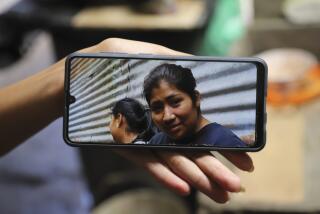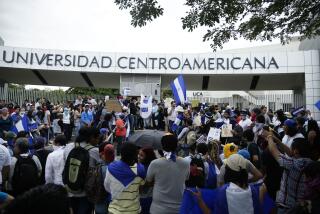Air Raid Drills Part of Curriculum for Students in Nicaragua
- Share via
MANAGUA, Nicaragua — Like American children during the Cuban missile crisis, Nicaraguan students today are learning how to protect themselves from an enemy air raid.
At elementary and high schools throughout the country, students practice emergency procedures similar to those once taught in the United States: Stay away from the windows. Don’t panic. File calmly out of the classroom. Wait for the intermittent siren to signal the end of the attack.
But unlike the American children, who feared a missile attack from Cuba, Nicaraguan students are bracing themselves for an invasion of American soldiers.
“Civil defense is a system of security measures to protect the population and economic resources from an earthquake, fire or aerial bombardment,” said 10-year-old Jimena Rivera, a 4th grader at the Instituto Pedagogico. “When we see there is an invasion, first we have to stay calm and then move to a place where there are no houses or trees to fall on top of us.”
The Nicaraguan government is fighting a war against the contras, U.S.-backed anti-Sandinista guerrillas. The Ministry of Education added the civil defense class to the regular school curriculum beginning last August, about the time that Congress approved $100 million in U.S. military and economic aid to the contras.
Managua was destroyed by an earthquake in 1972 that killed thousands, and the capital suffers from frequent flooding after torrential rains. But the main focus of the civil defense course is on the war against the contras, which Sandinista military leaders believe will ultimately lead to direct U.S. intervention here.
Similar courses are given to adults at their workplaces, and civil defense advertisements recently began to appear in newspapers. “In case of aggression. . . . What to do afterwards,” the ads say, advising the public to attend immediately to the wounded, rescue victims trapped beneath rubble, fight fires caused by bombing and stay tuned to an emergency national radio transmission.
In the United States, school air raid drills were commonly practiced in the 1950s, when atomic weapons testing began, and during the 1962 Cuban missile crisis.
In Nicaraguan schools, the half-hour weekly courses often are political as well as practical.
“They talk about the war and about the $100 million the contras are going to receive,” said Eddy Morales, 12, a fifth grader.
One illustration in a Ministry of Education teachers’ manual for 4th- to 6th-grade classes shows U.S. bombers zeroing in on a schoolhouse with children running to a shelter.
“The principal threat against Nicaragua is U.S. imperialism and its allied countries,” the lesson guide says. “The U.S. aggression has many aspects which are economic, military and political. When we refer to the military aspect, we are talking about armed aggression.”
The teachers are to explain the difference between air, land and sea attacks, as well as types of weapons--bombs, rockets and artillery. They describe environmental disasters, from gas leaks to biological warfare, and teach protection measures to keep casualties to a minimum.
“There have been sad cases all over the world where people have died in a war because they were not organized and did not know what to do,” said Mariam Arguello, 18, a student at the Colegio Calasanz.
Arguello, a Sandinista Youth leader, helps to teach the civil defense course in her history class, where girls outnumber boys four to one because so many 17- and 18-year-olds are fighting the war.
Some parents say they are reassured by the civil defense courses because their children will know what to do if they are not with them during an attack or natural disaster. Others object to the emphasis on war, weaponry and Sandinista politics, which they say are overplayed in the schools and on television.
“There is a war,” said Uriel Torres, 9, a 4th grader. “If there is an invasion, there will be death, destruction and a scarcity of things. . . . I don’t like the class because war is ugly.”
Torres said his parents, who do not support the Sandinistas, have told him to listen to the lessons about first aid and to ignore the politics.
Some grammar school students interviewed said they thought the civil defense class was boring. Most said they were not frightened by the class, as some parents suggested, and most said they did not believe there would be an invasion by the United States or by the contras.
At the Instituto Ramirez Goyen, however, several high school students interviewed took the civil defense lesson quite seriously, noting that the campus was about a mile from Nicaragua’s only oil refinery, which is often cited as a potential target for a contras commando attack.
“In civil defense, we talk about what we would do if the refinery blew up. If we are in school and something happens, now we know how to save a few people,” said Maria Mercedes Moreira, 18.
In a classroom covered with revolutionary murals, the discussion during a recent night session for working students included public hygiene measures to avoid epidemics and ways to treat trauma.
“Remember after the war what we saw in children?” asked the teacher in one class, referring to the insurrection that brought the Sandinistas to power in 1979. “Nervousness. They couldn’t sleep or eat. They were tense.”
Unlike the grammar school children, these high school students seemed to believe that a U.S. attack by air or ground troops is inevitable. During the first third of this century, the United States intervened twice in Nicaragua, keeping troops here for prolonged periods at the request of shaky local governments in hopes of resolving chaotic political situations.
“In the mountains, they live the aggression every day,” said Cristina Dabela, 19, a Sandinista supporter. “In the capital, we’re just waiting for a direct invasion, for the Yankees to come with all of their sophisticated arms.”
More to Read
Sign up for Essential California
The most important California stories and recommendations in your inbox every morning.
You may occasionally receive promotional content from the Los Angeles Times.













